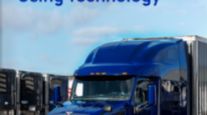iTECH: Document Imaging Goes Mobile
By Dan Leone, Staff Writer
This article appears in the February/March 2011 issue of iTECH, published in the Feb. 14 print edition of Transport Topics. Click here to subscribe today.
Electronic commerce is a term associated most readily with consumer-oriented retail sales tools such as Amazon.com, eBay.com and the like, but the electronic transaction of commerce has been de rigueur for the trucking industry for years. Motor carriers were selling their services and billing their customers over the Internet well before the public’s unbridled enthusiasm for e-commerce led to a boom in online sales of everything from household goods to classic cars.
Because much of the trucking industry’s business is transacted when the wheels of the trucks aren’t turning, truck stops have emerged as e-commerce hubs. Just about anything a driver can do at an interstate travel center — weigh a truck, repair a truck, fuel a truck, submit paperwork, order a burger — can be done electronically.
Of all these things, document scanning is acknowledged — even by those who don’t sell the service — as the wellspring from which all truck-stop e-commerce flows. Truck-stop scanning allows for over-the-Internet paperless transmission of the revenue-critical paperwork amassed by drivers on their runs.
“It was the revenue potential from doing scanning that basically launched the idea of high-speed lines in the truck stops,” said Bob Helms, chairman and CEO of Pegasus TransTech Corp., Tampa, Fla. “There was no way to do it before; the file sizes of [scanned documents] were too big for dial-up [Internet services].”
Besides being the grandfather of truck-stop e-commerce, scanning also is the truck-stop e-commerce service that is changing most rapidly, and possibly moving away from the centers. The nature of the change will depend upon the sort of technology that fleets do — or do not — gravitate toward, scanning companies said.
In the aggregate, enormous sums of money are tied up in driver paperwork, and no cash changes hands until that paperwork gets home from the road. The quicker the accounting department gets a driver’s paperwork, the quicker that carrier gets paid.
“The game changer in the industry was the truck-stop scanning,” said Mitch Steenrod, chief financial officer of Pilot Flying J, the largest truck-stop chain in the country. “That reached to the masses.”
Tom Liutkus, vice president of marketing and public relations at TravelCenters of America, also identified scanning as one of the cornerstone technologies that helped drivers on the road — and clerical personnel at carriers’ offices — become accustomed to transacting day-to-day commerce electronically.
Love’s Travel Stops and Country Stores spokeswoman Jennifer Love Meyer likewise described scanning as a “key” part of the chain’s business.
What is now truck-stop scanning was once a simple express mail delivery service facilitated by companies that recognized a business opportunity when they saw one: Set up shop where drivers congregate and charge a fee for rescuing truckers from pushing paper. TripPak began 20 years ago as an express mail service that rushed paperwork to the home office from a truck stop with as much speed as was possible at the time.
As broadband Internet entered the mainstream at the end of the 1990s, truck-stop chains were attempting to justify — that is, wring revenue from — the considerable capital outlay required to set up high-speed Internet infrastructure for hundreds of travel centers.
The document-scanning business provided the justification they were looking for.
Helms pinpointed July 2002 as the effective start date for his company’s scanning services. Today, Pegasus provides scanning services at all Pilot Flying J truck stops and all Love’s Travel Stops — that’s more than 800 truck-stop locations, by Pegasus’ tally.
Around that start time, ACS TripPak also went digital and since has become the scanning services provider at TravelCenters of America. Both Pegasus and TripPak handle millions of transactions a day.
Those millions of digital transactions have helped fleets combat what one carrier’s CFO called the “administrative nightmare” associated with processing “trip documents,” or the paperwork created on the road.
David Jackson, the chief financial officer of truckload carrier Knight Transportation, said that before documents could be scanned, his company employed “a small army of people” to collect and process the mailbags full of trip documents that arrived at Knight’s Phoenix headquarters each day.
That “army” of personnel has since been redeployed to other areas of Knight’s business, a happy by-product of the digital document’s ability to “reduce the cost of the process of collecting paperwork.”
Over time, the term “document scanning” has been replaced by “document imaging” — a twist of lexicon that reflected the ability to turn paper documents into digital documents without feeding any paper through a scanner the size of a refrigerator. Now, the scanning capabilities inherent in camera-enabled portable devices are introducing a new way to get information from the truck cab to the manager’s desk.
“I think the idea of truck-stop scanning is migrating away from the truck stop,” said Cassidy Smirnow, vice president of business development for ACS TripPak. “Sometimes, drivers are going very far out of route just to scan a document. We don’t need to scan [the paperwork], we just need to capture it.”
Portable scanners, which are considerably smaller than the mini-refrigerators that some drivers keep in their cabs, can be employed for this purpose, Smirnow said. So can smart phones, since many of them have built-in cameras.
At the time of this writing in early January, TripPak In-Cab, the commercial manifestation of the company’s philosophy that truck-stop scanning need not be truck-stop scanning forever, was about a year and a half old.
The anchor technologies for TripPak Mobile are laptop computers, smart phones, portable scanners, and high-speed wireless Internet that drivers can access from, among other places, truck stop parking lots.
“We’ve had great success with that over the past few months,” Smirnow said of the in-cab product.
Even the phone-based version of TripPak mobile — exclusive to Apple Inc.’s iPhone, for now — has done well. Smirnow didn’t share numbers, but she said that downloads of TripPak mobile for the iPhone have doubled since the app came out of its beta test phase in September.
TripPak Mobile’s page on iTunes, Apple’s distribution channel for iPhone apps, revealed uniformly positive, if sparse, feedback from users.
None of this is to say that TripPak has any intention of removing its scanning business from truck-stops entirely; the company plans to continue offering scanning at all 165 TravelCenters locations.
“I don’t think it’s going away any time soon,” Smirnow said.
Helms at Pegasus put it another way: “We have had personal scanning with a driver’s own laptop for some time now, but at the end of the day . . . if a driver or a trucking company invests in some sort of portable device that’s going to be carried in the truck, the cost of that device and the cost to communicate off of it exceeds any possible savings from being able to do that scan an hour or two earlier instead of going to the truck stop.”
“The truck-stop scanners are cleaned twice a day, serviced on a regular basis,” Helms told iTECH. “Once that driver’s [portable] scanner gets a little age on it, it may or may not be able to produce the same quality.”
Helms stressed that his business growth prospects remained tethered to document scanning that happens inside truck stops, but he acknowledged that his company was, like TripPak, responding to demand for more mobile offerings.
Pegasus launched software for personal computers three years ago and plans to release a scanning application for smart phones later this year, but Helms wouldn’t say exactly when.
As for truck stop operators, those reached by iTECH for this story were keeping their minds open about the future form of scanning services.
Liutkus, the PR point man at TravelCenters, summed up the truck-stop chain’s point of view succinctly: “Drivers have all different capabilities in terms of how they organize themselves.”




